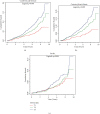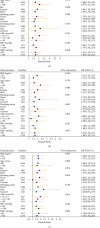Associations of the Cardiometabolic Index with the Risk of Cardiovascular Disease in Patients with Hypertension and Obstructive Sleep Apnea: Results of a Longitudinal Cohort Study
- PMID: 35783191
- PMCID: PMC9246614
- DOI: 10.1155/2022/4914791
Associations of the Cardiometabolic Index with the Risk of Cardiovascular Disease in Patients with Hypertension and Obstructive Sleep Apnea: Results of a Longitudinal Cohort Study
Abstract
Purpose: We aimed to explore the relationship between the cardiometabolic index (CMI) and cardiovascular disease (CVD) and its subtypes (coronary artery disease and stroke) in patients with hypertension and obstructive sleep apnea (OSA).
Methods: We conducted a retrospective cohort study enrolling 2067 participants from the Urumqi Research on Sleep Apnea and Hypertension study. The CMI was calculated as triglyceride to high-density lipoprotein cholesterol ratio × waist-to-height ratio. Participants were divided into three groups (T1, T2, and T3) according to the tertile of CMI. The Kaplan-Meier method helped to calculate the cumulative incidence of CVD in different groups. We assessed the association of CMI with the risk of CVD and CVD subtypes by estimating hazard ratios (HRs) and 95% confidence intervals (CIs) using Cox models.
Results: During a median follow-up of 6.83 years (interquartile range: 5.92-8.00 years), 326 incident CVD were identified, including 121 incident stroke and 205 incident coronary heart disease (CHD). Overall, after adjusting for confounding variables, CMI was positively associated with the risk of new-onset CVD (per SD increment, adjusted HR: 1.31; 95% CI: 1.20, 1.43), new-onset CHD (per SD increment, adjusted HR: 1.33; 95% CI: 1.20, 1.48), and new-onset stroke (per SD increment, adjusted HR: 1.27; 95% CI: 1.10, 1.47). Similar results were obtained in various subgroup and sensitivity analyses. Adding CMI to the baseline risk model for CVD improved the C-index (P < 0.001), continuous net reclassification improvement (P < 0.001), and integrated discrimination index (P < 0.001). Similar results were observed for CHD and stroke.
Conclusion: There was a positive association between CMI levels and the risk of new-onset CVD in patients with hypertension and OSA. This finding suggests that CMI may help identify people at high risk of developing CVD.
Copyright © 2022 Xintian Cai et al.
Conflict of interest statement
The authors deny any conflict of interest with this manuscript.
Figures




References
-
- Walli-Attaei M., Joseph P., Rosengren A., et al. Variations between women and men in risk factors, treatments, cardiovascular disease incidence, and death in 27 high-income, middle-income, and low-income countries (PURE): a prospective cohort study. Lancet . 2020;396(10244):97–109. doi: 10.1016/S0140-6736(20)30543-2. - DOI - PubMed
MeSH terms
LinkOut - more resources
Full Text Sources
Medical

